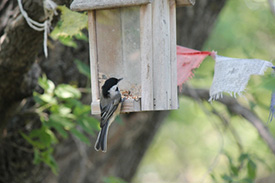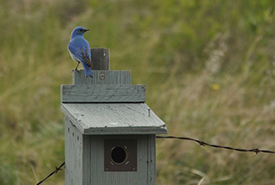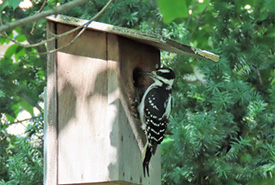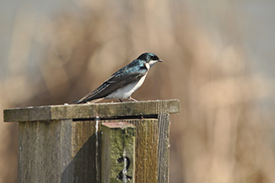All about bird houses and nesting boxes

Black-capped chickadee (Photo by Brent Keen)
When I was in elementary school, one of my favourite assignments was decorating a birdhouse. As with nearly all projects made by kids (macaroni necklace, anyone?), my birdhouse was never meant to house birds. It was more of an experiment in mixing watercolour paint and glitter glue onto the flimsiest bits of wood. Even though the birdhouse was never actually inhabited by birds, creating it was a fun activity and allowed us kids to ask about nature and wildlife. Now that I’m in university, my passion for wildlife habitat conservation is rooted in practical ways we can make positive change in our neighbourhoods.
If you’re interested in creating a birdhouse but want to make a longer-lasting home for birds, consider making a bird nesting box. Nesting boxes provide safe nesting habitat for birds, whereas birdhouses may not be able to accommodate large nests or hatchlings. Birds tend to live in nesting boxes for longer periods than birdhouses. Bird houses are often more decorative than practical, and birds will generally not return after the season.
One shining example of successful conservation using nesting boxes in Ontario is the Hazel Bird Nature Reserve, named after Hazel Bird’s hard work building hundreds of bird nesting boxes over the years. Hazel Bird’s impact was incredible and helped develop recovery efforts for the eastern bluebird in Ontario.
The Nature Conservancy of Canada (NCC) has been involved in restoration through the successful building of nesting boxes across Canada. On Alberta’s Cowboy Trail, NCC built nesting boxes specifically designed for the mountain bluebirds in the area. In the Grand Codroy Estuary in Newfoundland and Labrador, NCC staff worked alongside Ducks Unlimited Canada and a local elementary school to build nesting boxes for waterfowl. NCC has also installed nesting boxes in Saskatchewan at the Fairy Hill property to help tree swallows and mountain bluebirds.
To help birds in your neighbourhood, try creating a nesting box.
Know what birds you’re trying to attract

Mountain bluebird (Photo by Les Freck)
Different birds occur in different habitats. I’m very lucky to live near a huge forest. Every spring, I hear the chirping of chickadees and the occasional tap of a woodpecker’s beak. These birds are common in most cities, so you don’t have to be near a forest or conservation site to start building a nesting box. The more habitat diversity in your area, the more likely birds and other wildlife will have reason to live there.
Because birds look for worms and bugs in the grass, having a healthy yard can attract more birds. This can be something as simple as decreasing pesticide use, allowing your lawn to go longer periods without trimming, planting native flowers and growing herbs. Knowing what birds are attracted to which plants and insects can ensure birds regularly make your nesting box their home.
Creating your nesting box

Hairy woodpecker (Photo by David Gascoigne)
When creating your nesting box, it’s important to keep location in mind. A good one is placed somewhere stable while being accessible to birds, but not predators. The entry hole size can vary depending on what species of bird you’re trying to attract. Materials like pine, cedar, redwood and exterior-grade plywood are recommended if you’re building a nesting box yourself. If you aren’t overly crafty, don’t worry; some hardware stores sell easy to assemble or premade nesting boxes, so check your local hardware store to see if there are any options in your area.
Hygiene should be a priority when creating your nesting box. This shows another difference between birdhouses and nesting boxes: birdhouses don't usually have a way to open the box to allow for easy cleaning, but nesting boxes do. If you keep your nesting box clean after each season, birds are more likely to return. Thoroughly disinfect the box between nesting seasons. Wear a close-fitting mask to avoid breathing in any particles, debris or bacteria. After the birds have left, take out the old nest as carefully as possible. Wear gloves and scrub the inside with a stiff bristled brush.
Another reason to clean out your nest box is to reduce predation. Building a new nest on top of an old one means that the new nest is closer to the entrance hole and is therefore more easily reached by predators. Cleaning out the inside of your nesting box gives new birds a better chance at survival against potential predators.
Get creative

Tree swallow (Photo by Les Freck)
One of the great parts about making a bird home is that there are so many different ways to create them. Every bird species will be drawn to a different style of nesting box or birdhouse. In 2018, one of NCC’s conservation scientists Sarah Ludlow made a series of tube-shaped bird homes, designed specifically with chickadees in mind. By using just a few 30-centimetre-long PVC pipes, Sarah created a safe home for chickadee hatchlings in Saskatchewan.
Even if you aren’t making your own nesting box, you can still get creative with how you set it up. If you’re looking to attract chickadees specifically, try adding small wood chips on the bottom of the box to encourage nesting. It’s also important to remember that each nesting box should be built with certain specifications in mind in order to attract a specific type of bird. What attracts a chickadee won’t necessarily attract a martin. NestWatch has a detailed online resource with birds native to different regions and what types of nesting boxes attract them.
Though it may seem minor, adding a nesting box in your yard can help at-risk bird populations in your area. If you’ve already made a successful nesting box and want to keep supporting wildlife, check out NCC’s Small Acts of Conservation.


